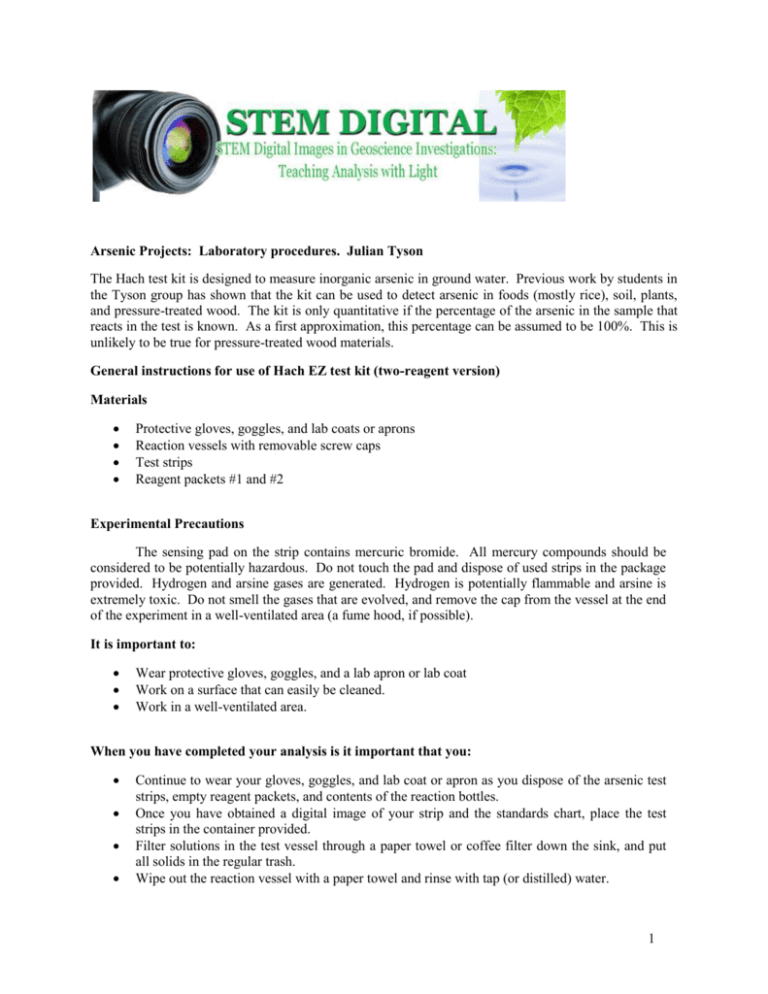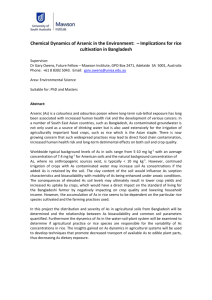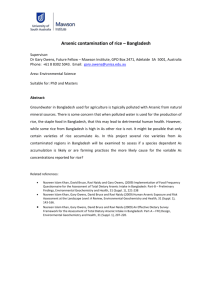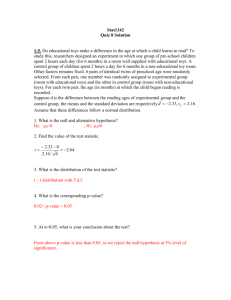Lab notes
advertisement

Arsenic Projects: Laboratory procedures. Julian Tyson The Hach test kit is designed to measure inorganic arsenic in ground water. Previous work by students in the Tyson group has shown that the kit can be used to detect arsenic in foods (mostly rice), soil, plants, and pressure-treated wood. The kit is only quantitative if the percentage of the arsenic in the sample that reacts in the test is known. As a first approximation, this percentage can be assumed to be 100%. This is unlikely to be true for pressure-treated wood materials. General instructions for use of Hach EZ test kit (two-reagent version) Materials Protective gloves, goggles, and lab coats or aprons Reaction vessels with removable screw caps Test strips Reagent packets #1 and #2 Experimental Precautions The sensing pad on the strip contains mercuric bromide. All mercury compounds should be considered to be potentially hazardous. Do not touch the pad and dispose of used strips in the package provided. Hydrogen and arsine gases are generated. Hydrogen is potentially flammable and arsine is extremely toxic. Do not smell the gases that are evolved, and remove the cap from the vessel at the end of the experiment in a well-ventilated area (a fume hood, if possible). It is important to: Wear protective gloves, goggles, and a lab apron or lab coat Work on a surface that can easily be cleaned. Work in a well-ventilated area. When you have completed your analysis is it important that you: Continue to wear your gloves, goggles, and lab coat or apron as you dispose of the arsenic test strips, empty reagent packets, and contents of the reaction bottles. Once you have obtained a digital image of your strip and the standards chart, place the test strips in the container provided. Filter solutions in the test vessel through a paper towel or coffee filter down the sink, and put all solids in the regular trash. Wipe out the reaction vessel with a paper towel and rinse with tap (or distilled) water. 1 Rinse off any liquid drops in the lid with clean water and pat dry with a paper towel The Experimental Procedure: 1. 2A. 2B. 3. 4. 5. 6. 7. 8. 9. 10. Lift the flap on the black cap and gently slide a test strip into the groove so that the reactive pad faces down over the small opening. Close the black flap. Weigh an empty reaction vessel. Add the solid sample and reweigh. Add water to the 50-mL mark. Add liquid sample to the 50-mL mark. Add the content of one reagent Packet #1 to the water and swirl until it has dissolved. For a solid sample, wait as long as you can for arsenic to be extracted. Add the content of one reagent Packet #2 to the vessel. Immediately cap the vessel but do not over tighten. Do not shake or invert the vessel. Swirl gently for 5 to 10 s. Do not splash the test strip. Let the reaction proceed for 40 min. Swirl the solution as often as you can during this time.. Remove the test strip and examine visually. If you were testing a piece of CCA-treated wood, the strip may well be “over-exposed” and your result is off the chart. For other materials you may get a color that is within the calibration range, in which case place the strip next to the chart of standard spots and photograph with a digital camera. Transfer the image to a computer and analyze with the ADI software. Plot the relevant R, G or B value as a function of the arsenic concentration and interpolate the arsenic concentration corresponding to your sample. Calculate the minimum concentration of arsenic in your sample. Camera Operation Any digital camera can be used; a Pentax Optio W90, a 12.1 megapixel, camera is suggested. The key components are: 1) Turn off the flash. 2) Check the ISO values, the default on cameras can be as high as 800. Change the default to the lowest setting. The camera used in the development of this experiment was set to ISO 100; ISO 80 also works. 3) Place it into the microscope mode if the camera has this setting. 4) Hold the camera straight over the picture. The camera should be 2-3 inches above the picture to be taken; it depends on the area of the picture to be taken. 5) Check the picture after the shot to make sure it is in focus and clear. Other key components of the camera used for this lab were: image tone was natural (camera default), white balance awb (camera default), sensitivity auto (camera default) sharpness, saturation, and contrast set in the middle (camera default.) 2 Instructions for preparation of rice. Note any information about the type of rice, supplier, country of origin, and any details of the location of harvest. 1. Laboratory version To approximately 20 g of rice add 100 mL of extractant (water, vinegar, Cola, bleach). Note the total weight. Boil for 10 min, cool and add water to restore original weight. Transfer 50 mL to reaction vessel and perform test according to the Hach instructions except that the vessel should be swirled numerous times during a minimum of a 40-min reaction period. Remove strip and photograph together with the calibration colors, in natural light if possible (if not try to ensure illumination is from a single source, such as an incandescent filament bulb or a fluorescent tube). Use digital image analysis software to extract the B value for the images and create a calibration curve by plotting B values as a function of concentration. Determine the concentration in the test solution by interpolation and hence calculate the concentration in the rice. Kitchen Version Equipment and supplies. Uncooked rice. Small saucepan with lid (preferably glass), liquid measures (tablespoon, teaspoon, cup, half-cup), measuring jug calibrated in milliliters (if possible). Cooking stove. Timer. Tap water. Digital camera. Procedure 1. Record activities with digital camera. Take close-up picture of rice and label(s) on package. 2. Boil rice Transfer 60 g [(4 tbsp + 2 tsp), 0.3 cup] rice into the saucepan. Add 300 mL (or 1 and one-third cups) cold water from tap. Cover with lid. Bring to boil and boil very gently for 10 min. If froth forms, wait until foam rises nearly to lid, then lift lid a few centimeters to collapse foam and replace. Decant 50 mL of hot liquid into the plastic bottle, cap loosely and allow to cool to room temperature. Calculate arsenic content of rice. Assume that no liquid was lost, so that you took a 50 mL sample from the original 300 mL. Assume that all the arsenic has been extracted from the rice and that all the arsenic compounds react in the test. Calculate the arsenic concentration in the solid rice in µg kg-1 (ppb) in the rice solid. For example, if the solution contained 15 ppb (ng mL-1), the rice would contain 75 ppb (ng g-1). In more detail Mass of arsenic in vessel in ng = 15 x 50 = 750 ng So mass of arsenic in rice sample = 750 x (300/50) = 4500 ng So concentration of arsenic in rice in ng per g = 4500/60 = 75 ng per g, which is ppb. 3








